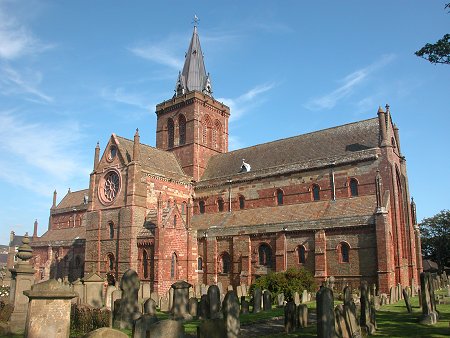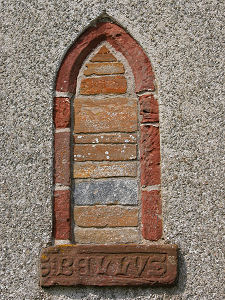 St Magnus Cathedral from the South-East |
Magnus Erlendsson, Earl of Orkney, sometimes known as Magnus the Martyr and later as Saint Magnus lived from 1080 to 16 April 1117. The year of his death is sometimes said to be 1115 or 1118, but 1117 seems to be most widely accepted. Magnus served jointly as Earl of Orkney with his cousin Håkon until the two fell out. Håkon subsequently betrayed and murdered Magnus, who later achieved sainthood and was commemorated by the building of St Magnus Cathedral in Kirkwall. The wider picture in Scotland at the time is set out in our Historical Timeline.
Magnus's grandfather was Thorfinn Sigurdsson, also known as Thorfinn the Mighty and Earl Thorfinn. He had twin sons, Erlend and Paul, who after Thorfinn's death went on to serve as joint Earls of Orkney. In 1098, King Magnus Barelegs of Norway took possession of Orkney and replaced Erlend and Paul as earls with his illegitimate son Sigurd. Later that same year Magnus and his cousin Håkon accompanied King Magnus Barelegs on a Viking raid on Anglesey in Wales. Håkon appears to have acquitted himself well during the Battle of Anglesey Sound, but Magnus, by now a man of considerable piety, refused to fight and was judged to be a coward by the Norwegian king.
As a result, Magnus had to take refuge in mainland Scotland. He returned to Orkney in 1105, where his cousin Håkon had been appointed Earl of Orkney. An appeal to King Eystein I of Norway, who had succeeded Magnus Barelegs in 1103, saw Magnus appointed as joint Earl of Orkney alongside his cousin Håkon. Things seem to have gone well until 1116, when the supporters of the two cousins fell out. The two sides met at the Thing (assembly) and it was agreed that in order to avoid all-out civil war the two earls would meet each other on the island of Egilsay after Easter, each bringing only two ships of supporters. The two sides would fight it out, and the winner would become the sole Earl of Orkney.
Magnus duly arrived on Egilsay with two ships, only for Håkon then to turn up with eight ships full of warriors prepared to support his cause. Magnus hid on the island overnight, but the following day was captured by Håkon's men. Magnus offered to accept exile or prison, but Håkon's supporters wanted to ensure that there was no chance he would ever return to challenge Håkon again. It was decided that Magnus should be killed. Håkon's standard bearer, Ofeigr, refused to execute Magnus, and Håkon made his cook Lifolf kill Magnus by striking him on the head with an axe, though only after Magnus had prayed for the souls of his executioners.
Magnus was buried where he had been killed. The place then miraculously turned into a green field. Magnus was subsequently reburied at Christchurch at Birsay, on Orkney's mainland, built by his grandfather Thorfinn. This has since been replaced by St Magnus Church. More miracles followed and a cult soon began to grow. In 1136 Bishop William of Orkney sanctified Earl Magnus, making him Saint Magnus. It is likely that St Magnus Church on Egilsay was built at this time near the site of the murder, probably as a replacement for an earlier church.
Magnus's nephew, Rognvald, became Earl of Orkney in 1137 and promised to build "a stone minster at Kirkwall" in memory of Saint Magnus. The original church comprised the choir of today's St Magnus Cathedral, and on its completion St Magnus's remains were brought from Birsay and interred in a column. After his death and subsequent sainthood, St Rognvald was also interred in the cathedral. During extensive restoration work in 1919 a skeleton was found behind stonework whose skull carried a wound consistent with the axe-blow said to have killed Magnus. Rognvald's bones had been found and re-interred during earlier work on the building in the 1800s.

